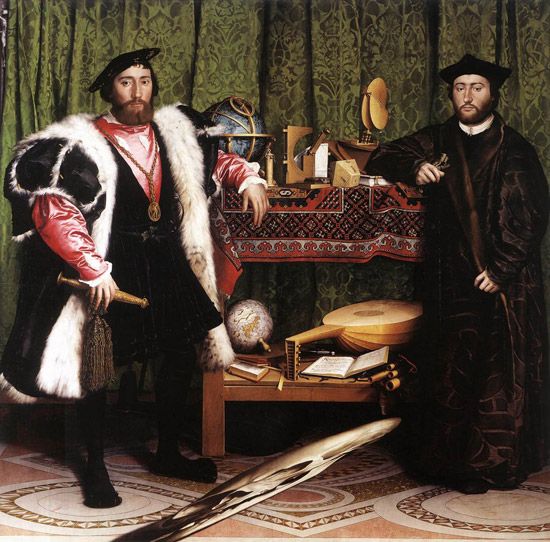Is a “Garden” the World’s Greatest New Artwork?
Francois Abelanet’s extraordinary turf “sculpture” on a Paris plaza epitomizes a grand tradition of artful illusion
/https://tf-cmsv2-smithsonianmag-media.s3.amazonaws.com/filer/20111129110005Abelanet-hotel-de-ville-globe-web.jpg)
What’s the best new work of art in the world? Good question. The most interesting and mind-bending new artwork that I’ve encountered is a remarkable garden in Paris titled Who to Believe?, recently designed and assembled by Francois Abelanet. We’re accustomed to the idea that paint can form an illusion. But it’s a bit startling to find this effect created with grass and trees. Yet this is the conceit of Abelanet’s work, made from 3,500 square feet of turf and many truckloads of dirt and straw and assembled with the help of about 90 carefully supervised gardeners. Here’s a pretty good video of it:
When you stare down at it from the steps of the City Hall in Paris, Abelanet’s carefully designed garden resembles a terrestrial globe. It’s a nearly perfect sphere, with neat lines marking latitude and longitude and two trees growing out of the top. It looks like one of those planets sketched by Antoine de Saint-Exupery in The Little Prince.
But move a little and its appearance changes. From any other angle, it’s an irregular crazy-quilt of shapes—a weirdly configured, Alice-In-Wonderland world. Abelanet has brought together two seemingly divergent artistic traditions—the French garden and Anamorphosis.
Gardens are one of the most notable accomplishments of French culture and reached their height in the work of André Le Notre (1613-1700), chief gardener for King Louis XIV (1638-1715), most notably at the Palace of Versailles. The distinguishing trait of French gardens is their geometric logic and mastery of vistas. From a vantage point at the center of the great terrace at Versailles, the eye is directed down grand avenues in which lines of trees, and strategically placed lakes, fountains and statues, lead the eye seemingly to infinity. Happiest when working on a grand scale, Le Notre sometimes moved entire villages to create the strictly regulated vistas that he wanted.
Notably, Le Notre was also interested in the dramatic impact of surprising effects which can be discerned from only one place. There’s an effect of this sort at the garden of Vaux-le-Vicomte, for example, created just before Versailles for the Minister of Finance, Nicholas Fouquet. Stand before the statue of the Gallic Hercules, which marks the end of the Grand Avenue, and look back at the Chateau: The reflection of the distant building floats, seemingly miraculously, on the surface of a body of water that’s very close to you. Visually, it seems impossible, although in fact it’s simply a careful application of an optical principle that had recently been enunciated by Descartes—“the angle of incidence equals the angle of reflection.” In other words, if we carefully choose the right vantage point, we can see the world in a way possible nowhere else.
This concept of a unique, privileged vantage point provides the basis for Abelanet’s garden. But unlike Le Notre’s work, it discloses a world which is not predictable and logical, or under our control, but topsy-turvy and unpredictable. In essence, he has combined the techniques of Le Notre with an approach to representation normally found only in painting.
Anamorphosis. The word, which is Greek, refers to an image that needs to be seen from a special angle to be seen without distortion. It’s a kind of zany extrapolation of the principles of perspective, and it developed early in the Renaissance, very soon after vanishing-point perspective was developed. The masterpiece of the genre is arguably a large and imposing painting by Hans Holbein in the National Gallery in London, The Ambassadors.

An ingenious visual puzzle, executed around 1533, The Ambassadors shows two nearly life-size figures who have been identified as Jean de Dintevile, the French ambassador to the court of Henry VIII and George de Sleve, Bishop of Lavaur. Behind them are a two-tiered table on which are piled a selection of books, globes (one terrestrial, one celestial) and scientific instruments, including a quadrant, an astrolabe and a sundial. There’s also a lute with a broken string, next to a hymnbook in Martin Luther’s translation. Scholars have long argued about what these objects signify. Presumably the instruments are saying something about the world of knowledge, or about the celestial and terrestrial world. The hymnbook and lute seem to allude to strife between scholar’s and clergy.
But the oddest thing in The Ambassadors is a strangely distorted shape in the lower center, which when viewed from the painting’s right (or the viewer’s left) takes the form of a skull. Surely this alludes to the fact that death is always present, but we only see it if we look at reality from a particular angle.
Holbein’s painting alerts us to the fact that Anamorphosis is a device that can not only amuse us with its strange visual distortions, but can provide a metaphor. Part of the wit of Abelanet’s marvelous garden is that it functions in a way that carries metaphorical and metaphysical punch. Probably no form on government on earth is so famously centralized and bureaucratic as that of France. Decisions made at the top are carried out rigorously to the lowest level. It’s been said that if you enter any schoolroom in France you’ll find that the students are studying the same page in the same book as in every other schoolroom in the realm. But how do the people at the top make their decisions? What do they see from their vantage point?
Abelanet’s garden reminds us that the view from City Hall can be quite different from everywhere else—that, in fact, the seeming logic of its view of things can be nonsensical. To fully grasp reality we need to see how it looks from more than one place (politicians, take note). Like much of the world’s best art, Abelanet’s creation is at once silly and profound.
Is this the world’s best new work of art? I’d welcome other suggestions.
/https://tf-cmsv2-smithsonianmag-media.s3.amazonaws.com/accounts/headshot/henry-adams-240.jpg)
/https://tf-cmsv2-smithsonianmag-media.s3.amazonaws.com/accounts/headshot/henry-adams-240.jpg)